Taxation Law: Residency Test and Capital Gains Tax
VerifiedAdded on 2023/06/04
|7
|1425
|312
AI Summary
This article discusses the residency test and capital gains tax in taxation law. The first question deals with determining the residency status of a taxpayer under different tests. The second question deals with the tax liability of a taxpayer on the sale of land. The article explains the laws, applications, and conclusions with solved examples. The subject is taxation law, and the course code and college/university are not mentioned.
Contribute Materials
Your contribution can guide someone’s learning journey. Share your
documents today.
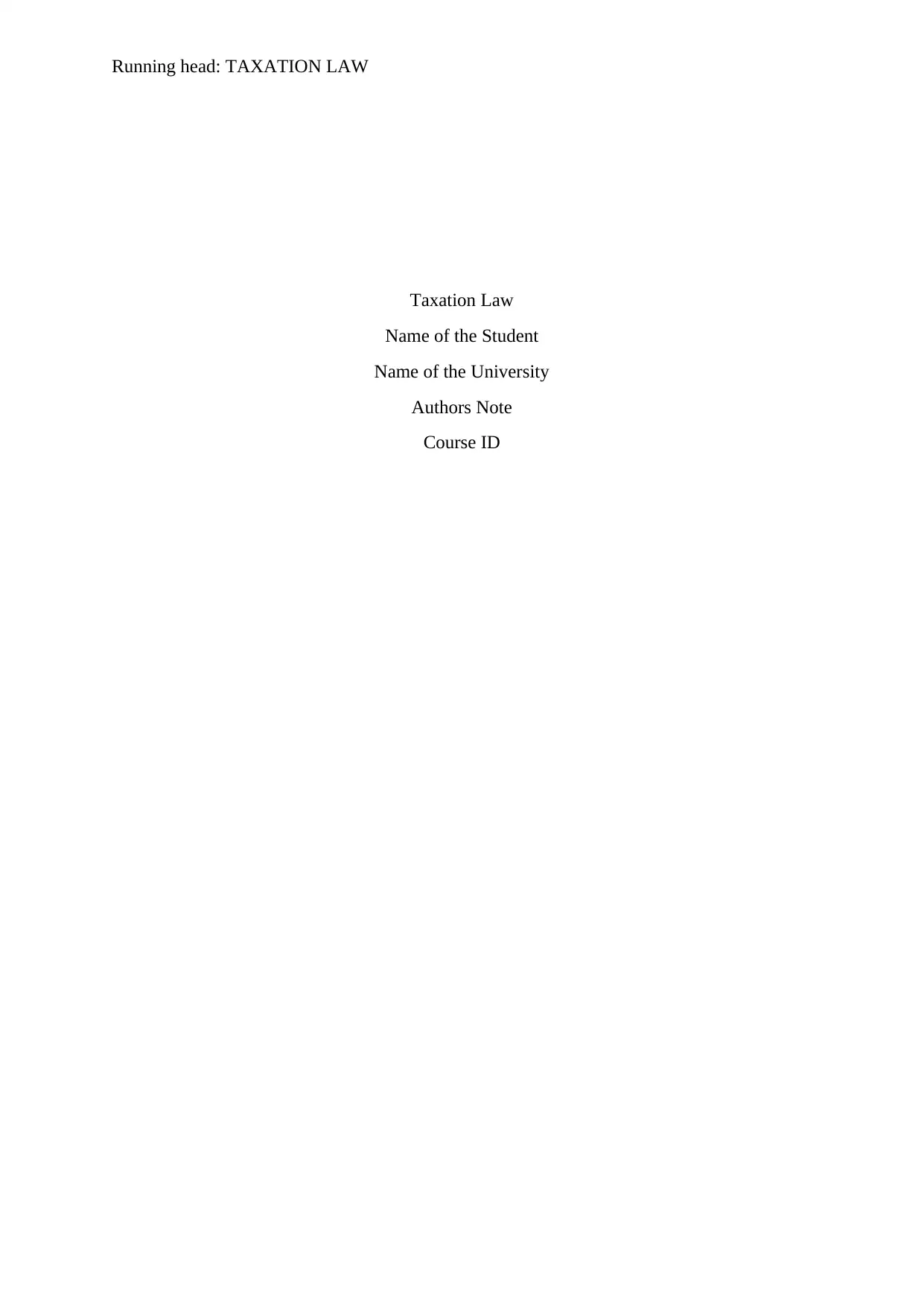
Running head: TAXATION LAW
Taxation Law
Name of the Student
Name of the University
Authors Note
Course ID
Taxation Law
Name of the Student
Name of the University
Authors Note
Course ID
Secure Best Marks with AI Grader
Need help grading? Try our AI Grader for instant feedback on your assignments.
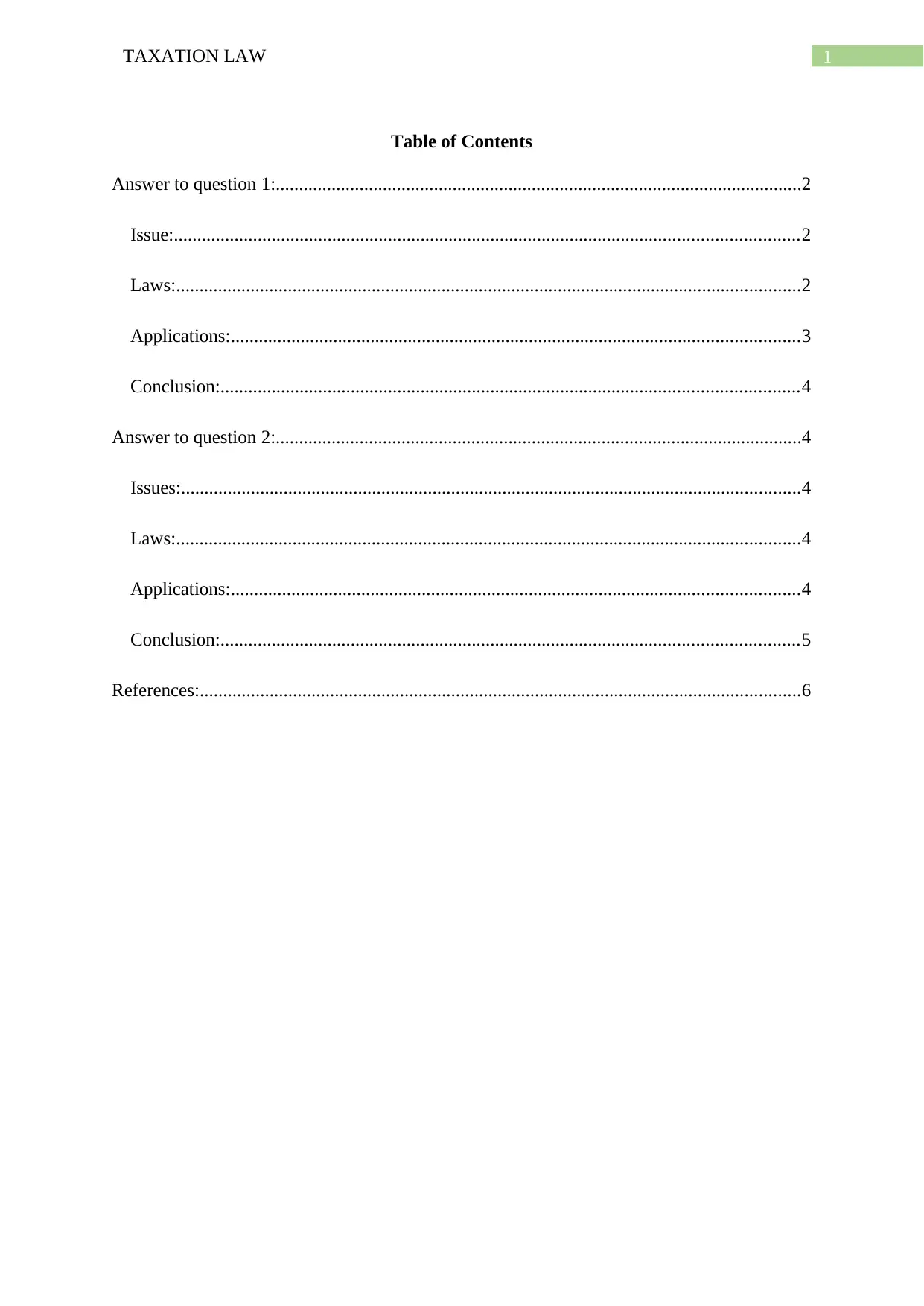
1TAXATION LAW
Table of Contents
Answer to question 1:.................................................................................................................2
Issue:......................................................................................................................................2
Laws:......................................................................................................................................2
Applications:..........................................................................................................................3
Conclusion:............................................................................................................................4
Answer to question 2:.................................................................................................................4
Issues:.....................................................................................................................................4
Laws:......................................................................................................................................4
Applications:..........................................................................................................................4
Conclusion:............................................................................................................................5
References:.................................................................................................................................6
Table of Contents
Answer to question 1:.................................................................................................................2
Issue:......................................................................................................................................2
Laws:......................................................................................................................................2
Applications:..........................................................................................................................3
Conclusion:............................................................................................................................4
Answer to question 2:.................................................................................................................4
Issues:.....................................................................................................................................4
Laws:......................................................................................................................................4
Applications:..........................................................................................................................4
Conclusion:............................................................................................................................5
References:.................................................................................................................................6
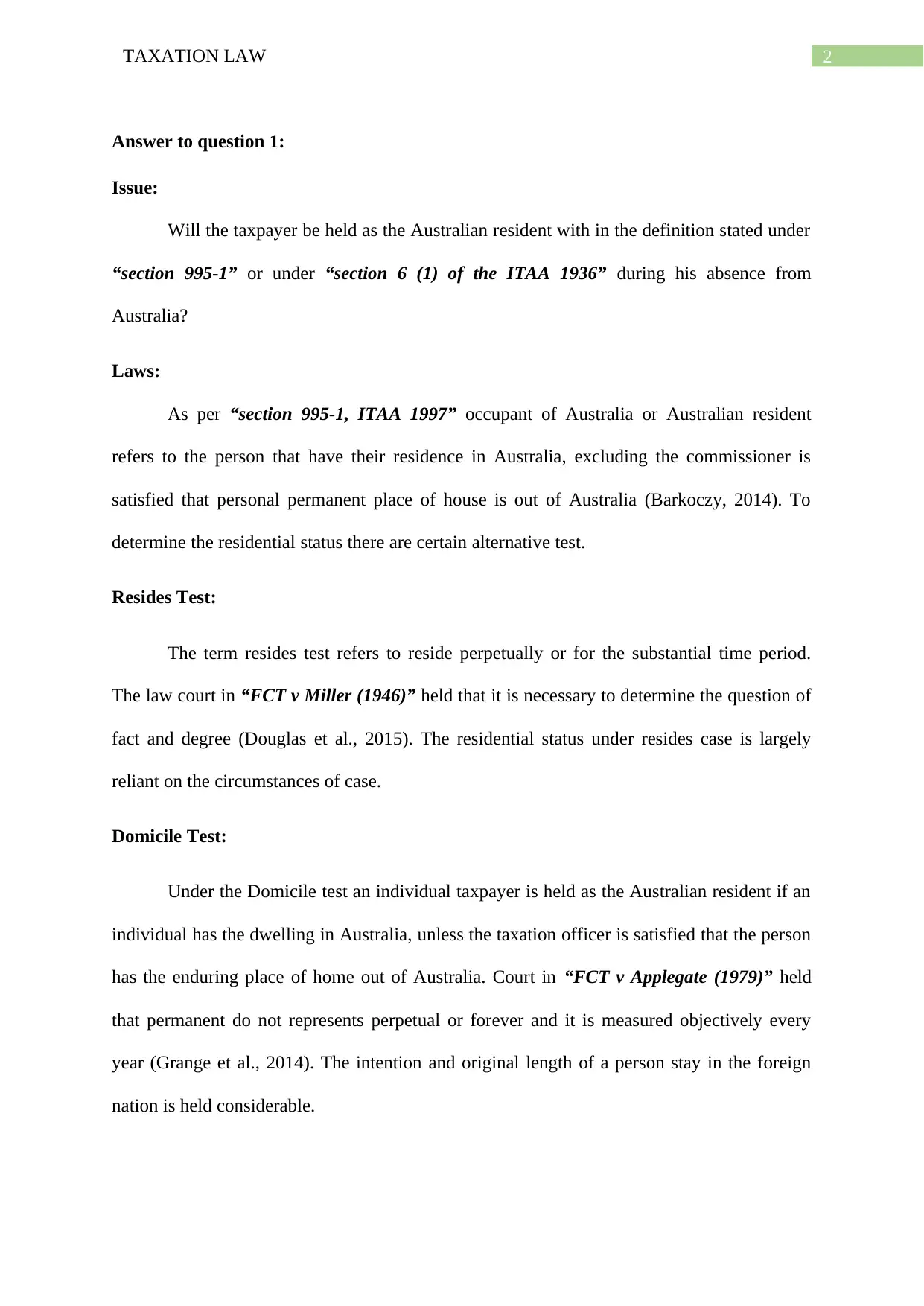
2TAXATION LAW
Answer to question 1:
Issue:
Will the taxpayer be held as the Australian resident with in the definition stated under
“section 995-1” or under “section 6 (1) of the ITAA 1936” during his absence from
Australia?
Laws:
As per “section 995-1, ITAA 1997” occupant of Australia or Australian resident
refers to the person that have their residence in Australia, excluding the commissioner is
satisfied that personal permanent place of house is out of Australia (Barkoczy, 2014). To
determine the residential status there are certain alternative test.
Resides Test:
The term resides test refers to reside perpetually or for the substantial time period.
The law court in “FCT v Miller (1946)” held that it is necessary to determine the question of
fact and degree (Douglas et al., 2015). The residential status under resides case is largely
reliant on the circumstances of case.
Domicile Test:
Under the Domicile test an individual taxpayer is held as the Australian resident if an
individual has the dwelling in Australia, unless the taxation officer is satisfied that the person
has the enduring place of home out of Australia. Court in “FCT v Applegate (1979)” held
that permanent do not represents perpetual or forever and it is measured objectively every
year (Grange et al., 2014). The intention and original length of a person stay in the foreign
nation is held considerable.
Answer to question 1:
Issue:
Will the taxpayer be held as the Australian resident with in the definition stated under
“section 995-1” or under “section 6 (1) of the ITAA 1936” during his absence from
Australia?
Laws:
As per “section 995-1, ITAA 1997” occupant of Australia or Australian resident
refers to the person that have their residence in Australia, excluding the commissioner is
satisfied that personal permanent place of house is out of Australia (Barkoczy, 2014). To
determine the residential status there are certain alternative test.
Resides Test:
The term resides test refers to reside perpetually or for the substantial time period.
The law court in “FCT v Miller (1946)” held that it is necessary to determine the question of
fact and degree (Douglas et al., 2015). The residential status under resides case is largely
reliant on the circumstances of case.
Domicile Test:
Under the Domicile test an individual taxpayer is held as the Australian resident if an
individual has the dwelling in Australia, unless the taxation officer is satisfied that the person
has the enduring place of home out of Australia. Court in “FCT v Applegate (1979)” held
that permanent do not represents perpetual or forever and it is measured objectively every
year (Grange et al., 2014). The intention and original length of a person stay in the foreign
nation is held considerable.

3TAXATION LAW
183 days Test:
An individual under the 183 days will be treated as the Australian occupant if he or
she has been present in Australia either continually or in breaks for the period of six months
during the income year (Kenny, 2014). An exclusion to this is that unless the official is
content that the person has the dwelling outside of Australia and has no purpose of taking up
the dwelling in Australia.
Applications:
As understood in the current case of Edward following his graduate was posted to
Singapore for two years. He closed all his bank accounts and also applied visa in Singapore
as he was not sure of returning back to Australia.
Under the “reside test” Edward will be held as non-resident of Australia. Citing the
reference of “FCT v Miller (1946)” Edward intention to remain out of Australia was for
unspecified time (Morgan et al. 2014). Therefore, the outcome of the test held Edward non-
resident.
With respect to “Domicile Test” Edward will be considered to have the permanent
place of dwelling in Singapore. Citing the example of “FCT v Applegate (1979)” Edward is
believed to have established the permanent place of abode outside Australia as his place of
abode in Singapore cannot be merely termed as transitory rather it was intended to be and
was as the matter of fact his home for the time being. Edward would be held as non-resident
under the “Domicile Test”.
Under the “183 days” test Edward was neither present in Australia continuously nor
intermittently for more than one half of the income year. Furthermore, it is also pleased that
183 days Test:
An individual under the 183 days will be treated as the Australian occupant if he or
she has been present in Australia either continually or in breaks for the period of six months
during the income year (Kenny, 2014). An exclusion to this is that unless the official is
content that the person has the dwelling outside of Australia and has no purpose of taking up
the dwelling in Australia.
Applications:
As understood in the current case of Edward following his graduate was posted to
Singapore for two years. He closed all his bank accounts and also applied visa in Singapore
as he was not sure of returning back to Australia.
Under the “reside test” Edward will be held as non-resident of Australia. Citing the
reference of “FCT v Miller (1946)” Edward intention to remain out of Australia was for
unspecified time (Morgan et al. 2014). Therefore, the outcome of the test held Edward non-
resident.
With respect to “Domicile Test” Edward will be considered to have the permanent
place of dwelling in Singapore. Citing the example of “FCT v Applegate (1979)” Edward is
believed to have established the permanent place of abode outside Australia as his place of
abode in Singapore cannot be merely termed as transitory rather it was intended to be and
was as the matter of fact his home for the time being. Edward would be held as non-resident
under the “Domicile Test”.
Under the “183 days” test Edward was neither present in Australia continuously nor
intermittently for more than one half of the income year. Furthermore, it is also pleased that
Secure Best Marks with AI Grader
Need help grading? Try our AI Grader for instant feedback on your assignments.
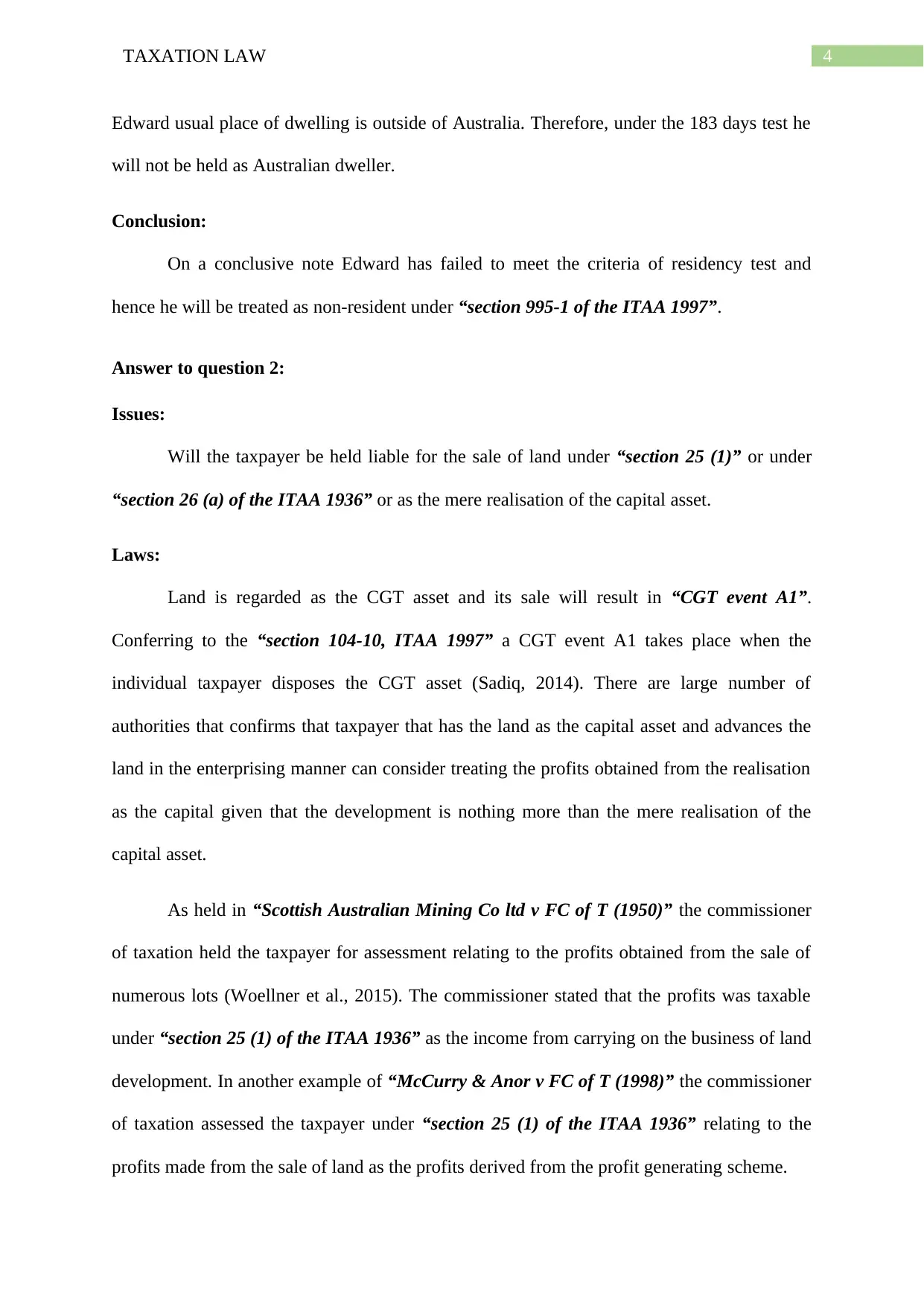
4TAXATION LAW
Edward usual place of dwelling is outside of Australia. Therefore, under the 183 days test he
will not be held as Australian dweller.
Conclusion:
On a conclusive note Edward has failed to meet the criteria of residency test and
hence he will be treated as non-resident under “section 995-1 of the ITAA 1997”.
Answer to question 2:
Issues:
Will the taxpayer be held liable for the sale of land under “section 25 (1)” or under
“section 26 (a) of the ITAA 1936” or as the mere realisation of the capital asset.
Laws:
Land is regarded as the CGT asset and its sale will result in “CGT event A1”.
Conferring to the “section 104-10, ITAA 1997” a CGT event A1 takes place when the
individual taxpayer disposes the CGT asset (Sadiq, 2014). There are large number of
authorities that confirms that taxpayer that has the land as the capital asset and advances the
land in the enterprising manner can consider treating the profits obtained from the realisation
as the capital given that the development is nothing more than the mere realisation of the
capital asset.
As held in “Scottish Australian Mining Co ltd v FC of T (1950)” the commissioner
of taxation held the taxpayer for assessment relating to the profits obtained from the sale of
numerous lots (Woellner et al., 2015). The commissioner stated that the profits was taxable
under “section 25 (1) of the ITAA 1936” as the income from carrying on the business of land
development. In another example of “McCurry & Anor v FC of T (1998)” the commissioner
of taxation assessed the taxpayer under “section 25 (1) of the ITAA 1936” relating to the
profits made from the sale of land as the profits derived from the profit generating scheme.
Edward usual place of dwelling is outside of Australia. Therefore, under the 183 days test he
will not be held as Australian dweller.
Conclusion:
On a conclusive note Edward has failed to meet the criteria of residency test and
hence he will be treated as non-resident under “section 995-1 of the ITAA 1997”.
Answer to question 2:
Issues:
Will the taxpayer be held liable for the sale of land under “section 25 (1)” or under
“section 26 (a) of the ITAA 1936” or as the mere realisation of the capital asset.
Laws:
Land is regarded as the CGT asset and its sale will result in “CGT event A1”.
Conferring to the “section 104-10, ITAA 1997” a CGT event A1 takes place when the
individual taxpayer disposes the CGT asset (Sadiq, 2014). There are large number of
authorities that confirms that taxpayer that has the land as the capital asset and advances the
land in the enterprising manner can consider treating the profits obtained from the realisation
as the capital given that the development is nothing more than the mere realisation of the
capital asset.
As held in “Scottish Australian Mining Co ltd v FC of T (1950)” the commissioner
of taxation held the taxpayer for assessment relating to the profits obtained from the sale of
numerous lots (Woellner et al., 2015). The commissioner stated that the profits was taxable
under “section 25 (1) of the ITAA 1936” as the income from carrying on the business of land
development. In another example of “McCurry & Anor v FC of T (1998)” the commissioner
of taxation assessed the taxpayer under “section 25 (1) of the ITAA 1936” relating to the
profits made from the sale of land as the profits derived from the profit generating scheme.
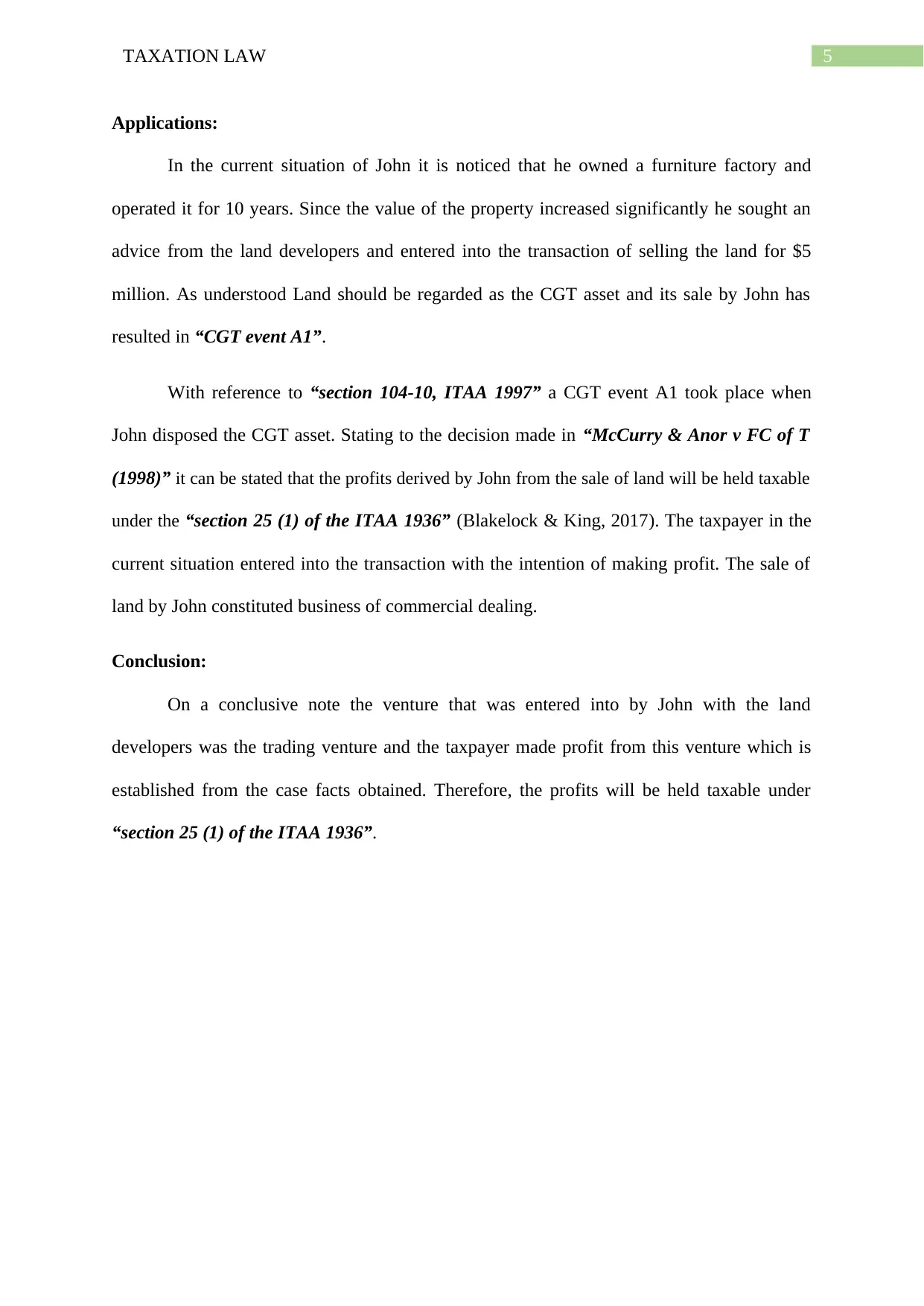
5TAXATION LAW
Applications:
In the current situation of John it is noticed that he owned a furniture factory and
operated it for 10 years. Since the value of the property increased significantly he sought an
advice from the land developers and entered into the transaction of selling the land for $5
million. As understood Land should be regarded as the CGT asset and its sale by John has
resulted in “CGT event A1”.
With reference to “section 104-10, ITAA 1997” a CGT event A1 took place when
John disposed the CGT asset. Stating to the decision made in “McCurry & Anor v FC of T
(1998)” it can be stated that the profits derived by John from the sale of land will be held taxable
under the “section 25 (1) of the ITAA 1936” (Blakelock & King, 2017). The taxpayer in the
current situation entered into the transaction with the intention of making profit. The sale of
land by John constituted business of commercial dealing.
Conclusion:
On a conclusive note the venture that was entered into by John with the land
developers was the trading venture and the taxpayer made profit from this venture which is
established from the case facts obtained. Therefore, the profits will be held taxable under
“section 25 (1) of the ITAA 1936”.
Applications:
In the current situation of John it is noticed that he owned a furniture factory and
operated it for 10 years. Since the value of the property increased significantly he sought an
advice from the land developers and entered into the transaction of selling the land for $5
million. As understood Land should be regarded as the CGT asset and its sale by John has
resulted in “CGT event A1”.
With reference to “section 104-10, ITAA 1997” a CGT event A1 took place when
John disposed the CGT asset. Stating to the decision made in “McCurry & Anor v FC of T
(1998)” it can be stated that the profits derived by John from the sale of land will be held taxable
under the “section 25 (1) of the ITAA 1936” (Blakelock & King, 2017). The taxpayer in the
current situation entered into the transaction with the intention of making profit. The sale of
land by John constituted business of commercial dealing.
Conclusion:
On a conclusive note the venture that was entered into by John with the land
developers was the trading venture and the taxpayer made profit from this venture which is
established from the case facts obtained. Therefore, the profits will be held taxable under
“section 25 (1) of the ITAA 1936”.
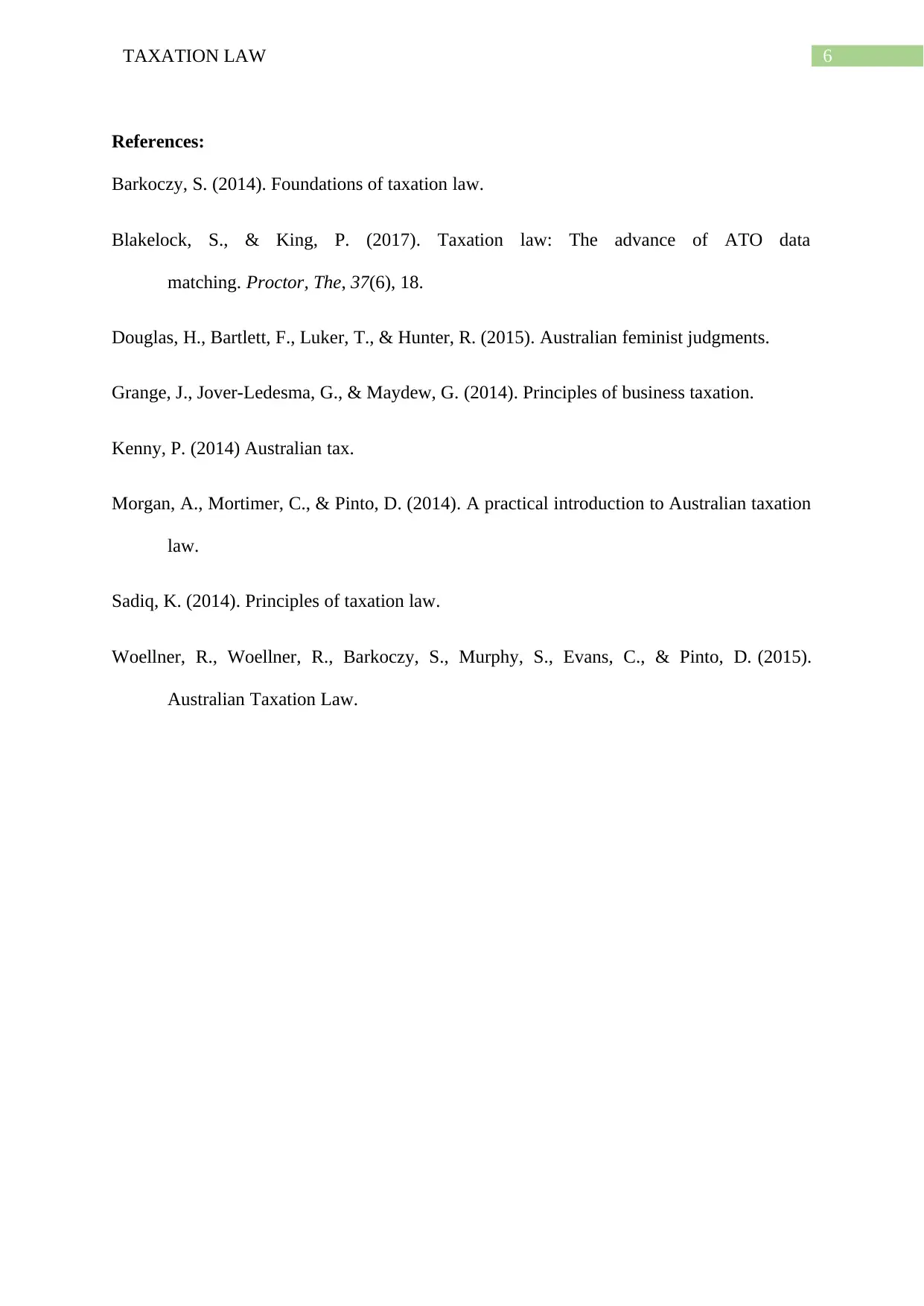
6TAXATION LAW
References:
Barkoczy, S. (2014). Foundations of taxation law.
Blakelock, S., & King, P. (2017). Taxation law: The advance of ATO data
matching. Proctor, The, 37(6), 18.
Douglas, H., Bartlett, F., Luker, T., & Hunter, R. (2015). Australian feminist judgments.
Grange, J., Jover-Ledesma, G., & Maydew, G. (2014). Principles of business taxation.
Kenny, P. (2014) Australian tax.
Morgan, A., Mortimer, C., & Pinto, D. (2014). A practical introduction to Australian taxation
law.
Sadiq, K. (2014). Principles of taxation law.
Woellner, R., Woellner, R., Barkoczy, S., Murphy, S., Evans, C., & Pinto, D. (2015).
Australian Taxation Law.
References:
Barkoczy, S. (2014). Foundations of taxation law.
Blakelock, S., & King, P. (2017). Taxation law: The advance of ATO data
matching. Proctor, The, 37(6), 18.
Douglas, H., Bartlett, F., Luker, T., & Hunter, R. (2015). Australian feminist judgments.
Grange, J., Jover-Ledesma, G., & Maydew, G. (2014). Principles of business taxation.
Kenny, P. (2014) Australian tax.
Morgan, A., Mortimer, C., & Pinto, D. (2014). A practical introduction to Australian taxation
law.
Sadiq, K. (2014). Principles of taxation law.
Woellner, R., Woellner, R., Barkoczy, S., Murphy, S., Evans, C., & Pinto, D. (2015).
Australian Taxation Law.
1 out of 7
Related Documents
Your All-in-One AI-Powered Toolkit for Academic Success.
+13062052269
info@desklib.com
Available 24*7 on WhatsApp / Email
![[object Object]](/_next/static/media/star-bottom.7253800d.svg)
Unlock your academic potential
© 2024 | Zucol Services PVT LTD | All rights reserved.




